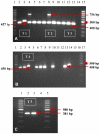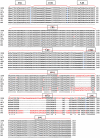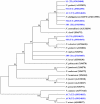Detection of Naegleria species in environmental samples from Peninsular Malaysia
- PMID: 21915311
- PMCID: PMC3167841
- DOI: 10.1371/journal.pone.0024327
Detection of Naegleria species in environmental samples from Peninsular Malaysia
Abstract
Background: In Malaysia, researchers and medical practitioners are unfamiliar with Naegleria infections. Thus little is known about the existence of pathogenic Naegleria fowleri, and the resultant primary amoebic meningoencephalitis (PAM) is seldom included in the differential diagnosis of central nervous system infections. This study was conducted to detect the presence of Naegleria species in various environmental samples.
Methods/findings: A total of 41 Naegleria-like isolates were isolated from water and dust samples. All these isolates were subjected to PCR using two primer sets designed from the ITS1-ITS2 regions. The N. fowleri species-specific primer set failed to produce the expected amplicon. The Naegleria genus-specific primers produced amplicons of 408 bp (35), 450 bp (2), 457 bp (2) or 381 bp (2) from all 41 isolates isolated from aquatic (33) and dust (8) samples. Analysis of the sequences from 10 representative isolates revealed that amplicons with fragments 408, 450 and 457 bp showed homology with non-pathogenic Naegleria species, and 381 bp showed homology with Vahlkampfia species. These results concurred with the morphological observation that all 39 isolates which exhibited flagella were Naegleria, while 2 isolates (AC7, JN034055 and AC8, JN034056) that did not exhibit flagella were Vahlkampfia species.
Conclusion: To date, pathogenic species of N. fowleri have not been isolated from Malaysia. All 39 isolates that produced amplicons (408, 450 and 457 bp) from the genus-specific primers were identified as being similar to nonpathogenic Naegleria. Amplicon 408 bp from 5 representative isolates showed 100% and 99.7% identity to Naegleria philippinensis isolate RJTM (AM167890) and is thus believed to be the most common species in our environment. Amplicons 450 bp and 457 bp were respectively believed to be from 2 new species of Naegleria, since representative isolates showed lower homology and had a longer base pair length when compared to the reference species in the Genbank, Naegleria schusteri (AJ566626) and Naegleria laresi (AJ566630), respectively.
Conflict of interest statement
Figures




Similar articles
-
Genetic variations in the internal transcribed spacer and mitochondrial small subunit rRNA gene of Naegleria spp.J Eukaryot Microbiol. 2003;50 Suppl:522-6. doi: 10.1111/j.1550-7408.2003.tb00617.x. J Eukaryot Microbiol. 2003. PMID: 14736150
-
First identification of Naegleria species and Vahlkampfia ciguana in Nile water, Cairo, Egypt: Seasonal morphology and phylogenetic analysis.J Microbiol Immunol Infect. 2020 Apr;53(2):259-265. doi: 10.1016/j.jmii.2018.06.003. Epub 2018 Jul 3. J Microbiol Immunol Infect. 2020. PMID: 30006270
-
Identification and phylogenetic position of Naegleria spp. from geothermal springs in Italy.Exp Parasitol. 2017 Dec;183:143-149. doi: 10.1016/j.exppara.2017.08.008. Epub 2017 Aug 12. Exp Parasitol. 2017. PMID: 28811103
-
What do we know by now about the genus Naegleria?Exp Parasitol. 2014 Nov;145 Suppl:S2-9. doi: 10.1016/j.exppara.2014.07.011. Epub 2014 Aug 6. Exp Parasitol. 2014. PMID: 25108159 Review.
-
Origin and evolution of the worldwide distributed pathogenic amoeboflagellate Naegleria fowleri.Infect Genet Evol. 2011 Oct;11(7):1520-8. doi: 10.1016/j.meegid.2011.07.023. Epub 2011 Aug 6. Infect Genet Evol. 2011. PMID: 21843657 Review.
Cited by
-
ACANTHAMOEBA SP.S-11 PHAGOCYTOTIC ACTIVITY ON MYCOBACTERIUM LEPRAE IN DIFFERENT NUTRIENT CONDITIONS.Afr J Infect Dis. 2018 Mar 7;12(1 Suppl):44-48. doi: 10.2101/Ajid.12v1S.5. eCollection 2018. Afr J Infect Dis. 2018. PMID: 29619429 Free PMC article.
-
Monitoring of Waterborne Parasites in Two Drinking Water Treatment Plants: A Study in Sarawak, Malaysia.Int J Environ Res Public Health. 2016 Jun 28;13(7):641. doi: 10.3390/ijerph13070641. Int J Environ Res Public Health. 2016. PMID: 27367710 Free PMC article.
-
Prevalence of Naegleria fowleri in Environmental Samples from Northern Part of India.PLoS One. 2015 Oct 20;10(10):e0137736. doi: 10.1371/journal.pone.0137736. eCollection 2015. PLoS One. 2015. PMID: 26484533 Free PMC article.
-
Prevalence of free-living amoebae in swimming pools and recreational waters, a systematic review and meta-analysis.Parasitol Res. 2022 Nov;121(11):3033-3050. doi: 10.1007/s00436-022-07631-3. Epub 2022 Aug 30. Parasitol Res. 2022. PMID: 36040629 Free PMC article.
-
Isolation of Naegleria spp. from a Brazilian Water Source.Pathogens. 2020 Jan 31;9(2):90. doi: 10.3390/pathogens9020090. Pathogens. 2020. PMID: 32024031 Free PMC article.
References
-
- De Jonckheere JF. Molecular definition and the ubiquity of species in the genus Naegleria. Protist. 2004;155:89–103. - PubMed
-
- Warhurst DC. Pathogenic free-living amoebae. Parasitol Today. 1985;1:24–28. - PubMed
-
- Diaz JH. Review on the increasing intracerebral infection caused by free-living amebae in the United State and Worldwide. Journal of Neuroparasitology. 2010;1:1–10.
-
- Sugita Y, Fujii T, Hayashi I, Aoki T, Yokoyama T, et al. Primary amebic meningoencephalitis due to Naegleria fowleri: an autopsy case in Japan. Pathol Int. 1999;49:468–470. - PubMed
Publication types
MeSH terms
LinkOut - more resources
Full Text Sources
Miscellaneous

